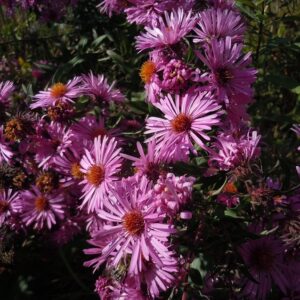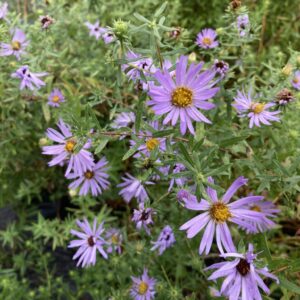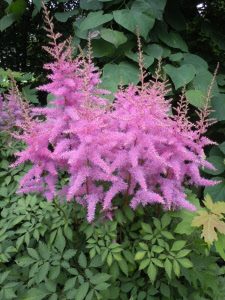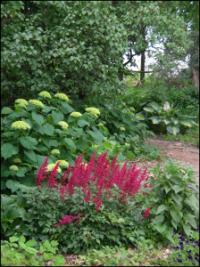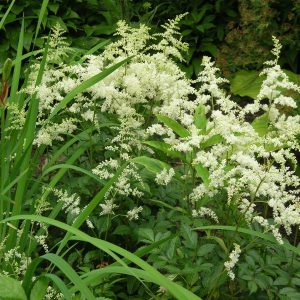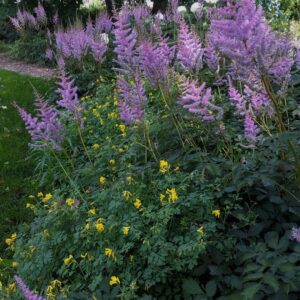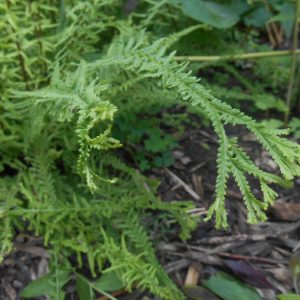Perennials & Biennials
Showing 65–72 of 484 results
-
Aster novae angliae syn. Symphyotrichum New England Aster Z 4-8
August – October, classic violet, pink or magenta daisies
August – October, classic violet, pink or magenta daisies
Size: 3-4' x 24"
Care: Full sun dry to moist soil. Heat and drought tolerant.
Native: Vt to Alabama, west to N. M., Wisconsin native
Wildlife Value: Nectar source for many butterflies - Checkered white and Checkered skippers, Spring azure, Pearl crescent, Buckeye, Painted lady, Fiery skip butterfly, Sachem, Sleepy orange, Silver-spotted skipper and Monarch. Host for caterpillars Wavy-lined emerald moth.Aster means star, referring to the flower’s form. For the Cherokee New England aster tea cured fevers and diarrhea. Roots remedied pain and inflammation of the nose and throat. Introduced to garden cultivation by John Tradescant the Younger (1608-1662) in 1637 when he sent it to England where upon borders of New England aster became common. Washington grew New England Aster at Mount Vernon.
-
Aster oblongifolius syn. Symphyotrichum oblongifolium, Aromatic aster Z 3-8
Purplish blue daisies with yellow centers blooming in September to November, Good, bushy mound shape. Called “aromatic” for the fragrance of its leaves.
Purplish blue daisies with yellow centers blooming in September to November, Good, bushy mound shape. Called “aromatic” for the fragrance of its leaves.
Size: 1-2’ x 1-3’
Care: sun to shade in well-drained to moist well-drained soil
Native: Pennsylvania to No. Carolina west to Wyoming & Texas, Wisconsin native
Wildlife Value: Bees collect pollen and nectar from it. Medium sized butterflies collect its nectar. Its leaves support Silvery checkerspot and some moth caterpillars, Deer resistant.
Size: Navajo made a decoction of this to protect against witches.Aster means star, referring to the flower’s form. Navajo made a decoction of this to protect against witches.
Meriwether Lewis collected this on the Expedition September 21, 1804, the day after nearly being swept away while Lewis and the Corps of discovery slept on an eroding sandbar, near the Big Bend of the Missouri River in South Dakota. 1st published description by planthunter Thomas Nuttall (1786-1879) in 1818..
-
Astilbe andresii ‘Amethyst’ Z 5-8
pink plumes flowering in July, with oxblood tinged foliage
OUT OF STOCK
Three foot tall pink plumes flowering in July, with oxblood tinged foliage
Size: 36"x 24"
Care: sun to part shade, moist soil essential. Immune walnut toxicity
Wildlife Value: attracts butterfliesAstilbe is Greek from a meaning “without” and stilbe meaning “lustre” referring to the fact that the leaves are not shiny. Early hybrid by George Arends, nurseryman from Ronsdorf, Gemany (1862-1952).
-
Astilbe andresii ‘Fanal’ Z 4-8
Marlboro red plumes in June
Striking Marlboro red plumes in June
Size: 24"x 18"
Care: sun to part shade, moist soil. Immune walnut toxicity
Wildlife Value: attracts butterflies
Awards: Royal Horticultural Society Award of Garden MeritAstilbe is Greek from a meaning “without” and stilbe meaning “lustre” referring to the fact that the leaves are not shiny. Cross of A. japonica and A. davidii made by Arends, nurseryman from Ronsdorf, Gemany (1862-1952), in 1930.
-
Astilbe andresii ‘Brautschleier’ Bridal Veil Z 4-8
White plumes turning creamy in July
White plumes turning creamy in July
Size: 30” x 30”
Care: sun to part shade, moist soil essentialAstilbe is Greek from a meaning “without” and stilbe meaning “lustre” referring to the fact that the leaves are not shiny. Hybrid by George Arends, nurseryman from Ronsdorf, Germany in 1929.
-
Astilbe chinensis luo xin fu in China Z 4-9
Pink plumes in mid-summer atop fern-like foliage. More tolerant of sun and well-drained soil than the hybrids.
Pink plumes in mid-summer atop fern-like foliage. More tolerant of sun and well-drained soil than the hybrids.
Size: 24” x 24” spreads
Care: Sun to shade in moist or moist well-drained soil
Native: Siberia, China, KoreaAstilbe from “the Greek word for without” and stilbe meaning “lustre” referring to the fact that the leaves are not shiny. 1st described for the West by botanist Carl Johann Maximowicz in 1859 and then named Hoteia chinensis. Liberty Hyde Bailey termed this plant “graceful” in the early 1900’s.
-
Astrantia major Masterwort Z 4-7
Blush white flower clusters on stalks growing from a single point on each stem stand tall above palmately divided foliage all summer
Blush white flower clusters on stalks growing from a single point on each stem stand tall above palmately divided foliage all summer
Size: 12-36” x 12”
Care: Sun to shade in moist to moist well-drained soil
Native: Europe
Awards: Elisabeth Carey Miller Botanical Garden Great Plant PicksAstrantia is Greek meaning “star” referring to the star-like appearance of the flowers. In European gardens by 1596 and colonial gardens in Plymouth Massachusetts Bay Colony in the 1630’s. Root used as a purgative.
-
Athyrium filix femina ‘Victoriae’ Victoria lady fern Z 4-8
Finely divided fronds have tiny, twisted leaves that cross one another. Vigorous grower. Dr, John Mickel, former curator of ferns at the New York Botanical Garden, called this “the Queen of green.” It is like no other fern.
OUT OF STOCK
Finely divided fronds have tiny, twisted leaves that cross one another. Vigorous grower. Dr, John Mickel, former curator of ferns at the New York Botanical Garden, called this “the Queen of green.” It is like no other fern.
Size: 18-24” x 18-24”
Care: part to full shade in moist to moist well-drained soilPopular Victorian fern. Discovered in Scotland in 1861.

